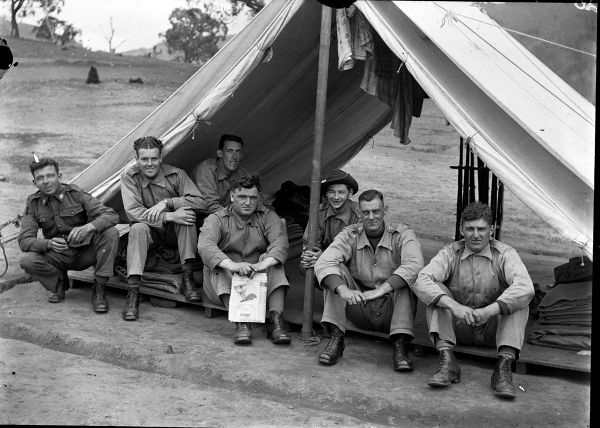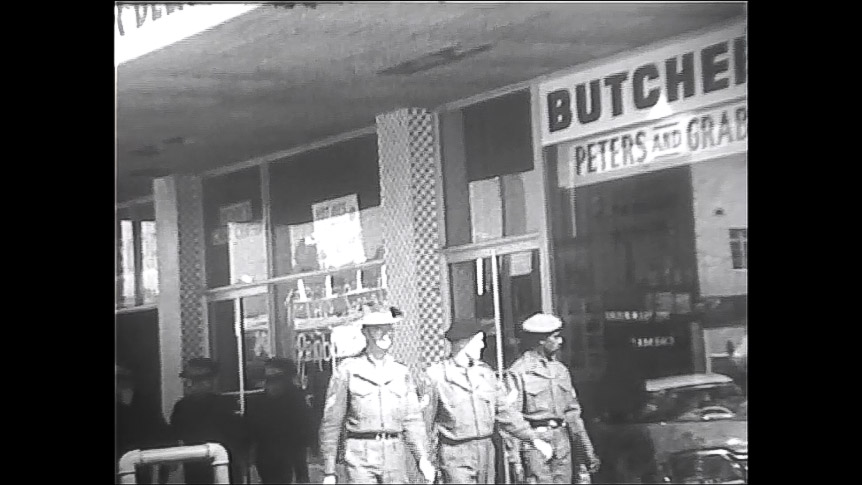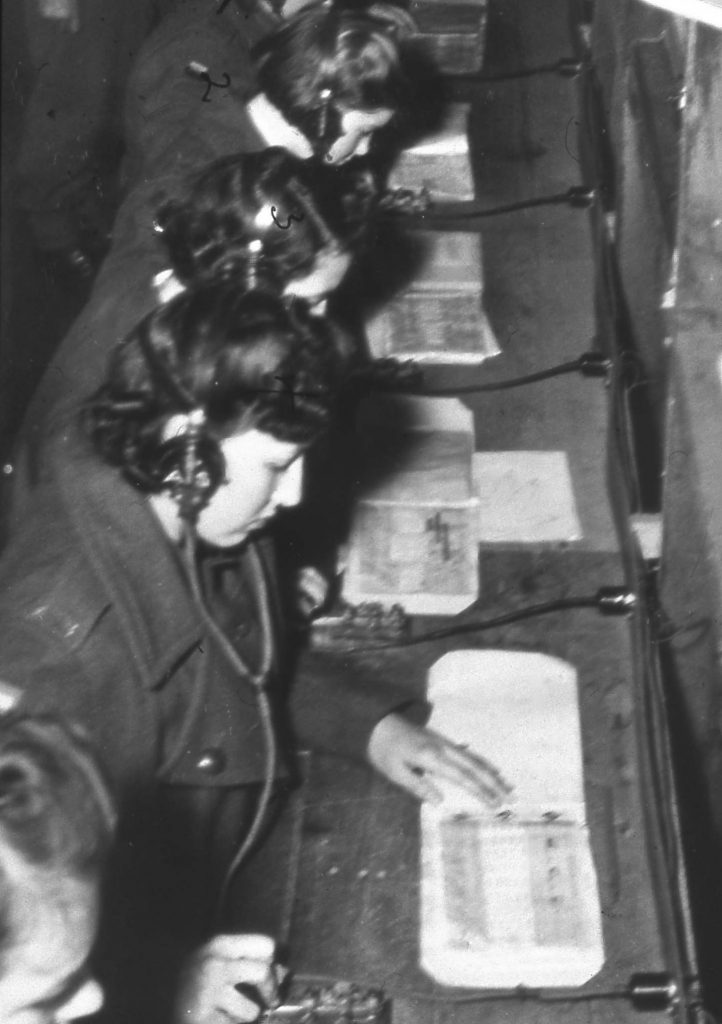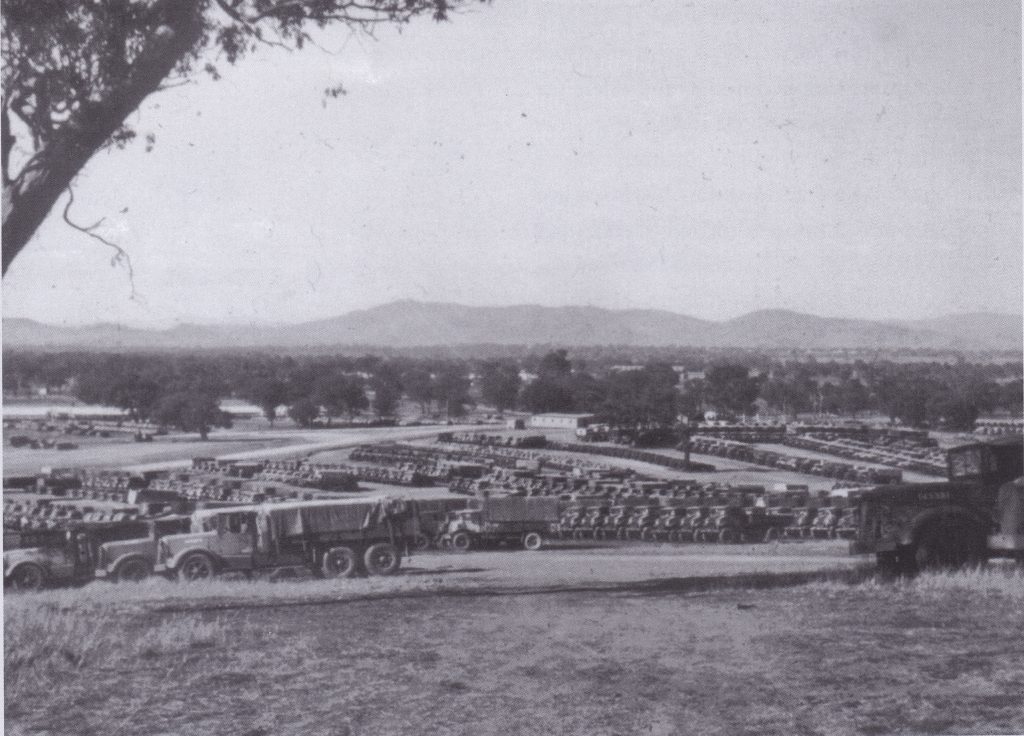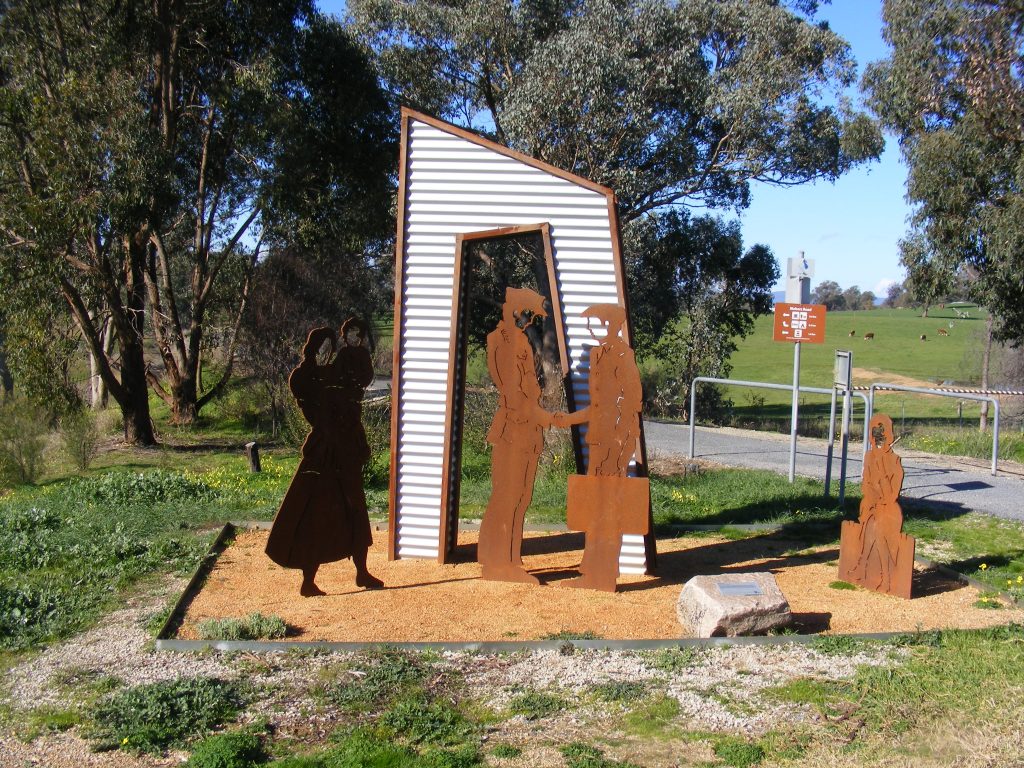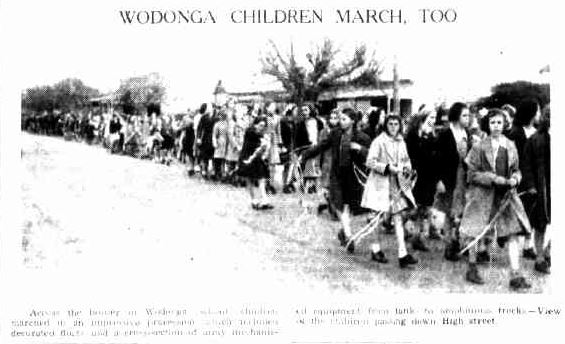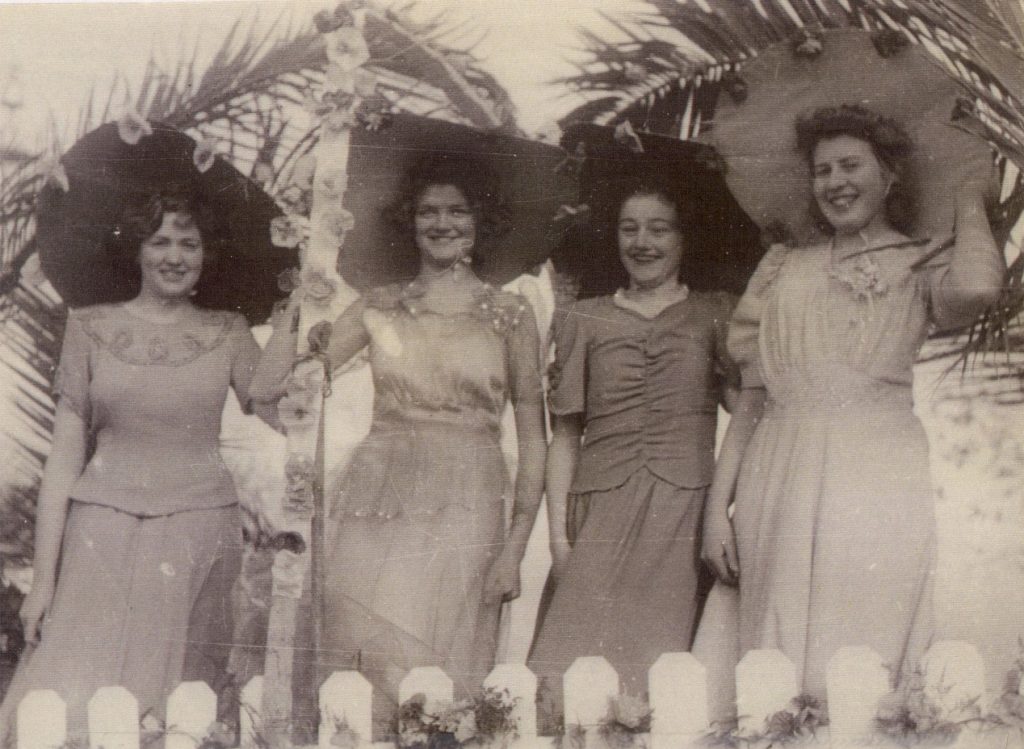THE IMPACT OF THE SECOND WORLD WAR ON WODONGA AND ITS SURROUNDS
PLACES AND STORIES
ABOUT THIS EXHIBITION
This online exhibition was prepared to mark the 75th anniversary of the end of the Second World War. It looks to the ways war proved a catalyst for change in Wodonga and its surrounds, by providing place memory prompts, access to trigger stories and an accompanying four-part essay.
BRIEF SUMMARY
Part 1: Memory Places
For general readers the memory places prompt a feel for place. They locate war and post-war related stories in what was visible during the 1940s. For students, they build on the notion within the National History Curriculum that ‘history is all around us’.
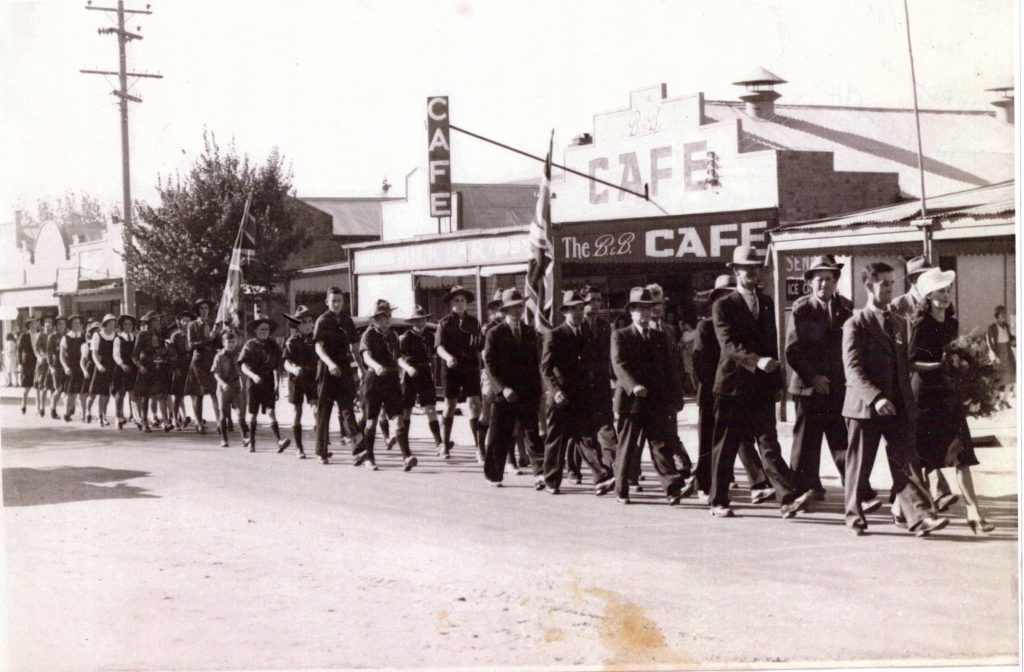
Four sets of memory places are plotted:
- Fighting the war on the home front
- War-time Wodonga
- Moving from war to peace, Wodonga, 1945-1949
- Cross river places linked to war-time and post-war Wodonga
Part 2: The Impact of the Second World War on Wodonga and its surrounds
The essay explains how the unprecedented national emergency of total war called on all the resources of the town and its countryside. It shows the local implications of post-war planning. It traces some of ways war insinuated itself into everyday life, upsetting established ways of thinking about gender and race/ethnic differences.
There are four parts:
- Fighting the War on the Home Front
Townspeople in Wodonga experienced the war on the home front in much the same ways as people did in small country towns elsewhere. They worried about absent loved ones; they endured the forced austerity of the war years; they struggled with drought and economic uncertainty. In addition however, they had to meet the challenges of coping with a large military presence and a busy railway and road crossing place.
- Planning post-war reconstruction
Throughout and beyond the war there was a clamour of ideas about how the post-war years might be different. Federal and state governments advanced post-war reconstruction plans. One such plan involved the establishment of a Murray Valley Region, which was important to the future of Wodonga.
- Moving from war to peace
In the immediate post-war years there were many suggestions about how Wodonga might be improved. War changed the way this border community situated itself in relation to others. It marked the awakening of a cross-border solidarity. Wodonga was called upon to be the immediate host community for the arrival of large numbers of displaced persons at Bonegilla.
- Social change
War acted as a catalyst for social change. Two of more obvious were shifts in everyday thinking and attitudes to gender roles and to race/ethnicity differences.
Part 3: Story investigations
For general readers, the clusters of contemporary media stories retrievable from Trove trigger investigations into what people were thinking and doing. For students exploring ‘the effects of the Second World War on the Australian home front and society’, the stories build on the observations within the National History Curriculum,
History is much more than the simple presentation of facts and dates from the past. History provides the skills for students to answer the question ‘How do we know?’ An investigation of an historical issue through a range of sources can stimulate curiosity and develop problem-solving, research and critical thinking skills.
There are eight clusters of 64 stories, represented here by a key story of the occasion which marked the transition from war to peace:
- ‘Wodonga’s Grand Show’, BMM 11 June 1946.
Locally VE Day had been celebrated as a British victory, aptly depicted by pictures of the Royal Family acknowledging the crowd at Buckingham Palace. VP day was a victory against the Japanese. It prompted expressions of thanksgiving, recognition of the sacrifices made by service personnel and spontaneous outbursts of joyous relief — illustrated pithily with the tearing apart of an effigy of Tojo, a Japanese Prime Minister and war leader. The celebrations of Victory Day in 1946, by way of contrast, were reflective. In both Wodonga and Albury there was an emphasis on ‘proud parades’ of youth, emphasising the hopes of a brighter, peaceful future. In Wodonga floral floats decorated and attended by business girls and girls from the new textile factory suggested something of ways that post-war the district was able to retain, even attract, youth. There was a strong military presence, indicative of the way Wodonga had become a garrison town. Giant sized Matilda and General Grant tanks clanked down High Street at the head of the procession. Speakers led the thanksgiving and acknowledged the contributions of those who had led and those who had fought. One speaker looked to the role played by ordinary people. He explained this had been ‘a people’s war and must lead to a people’s peace’.
Acknowledgements
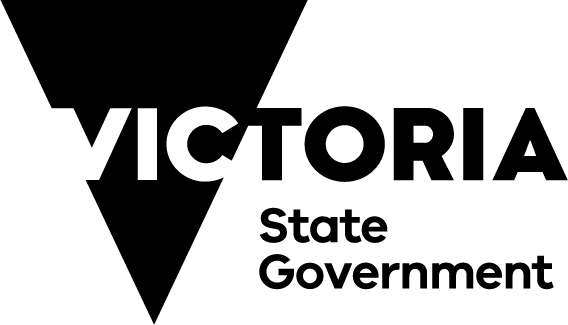
This exhibition was supported by the Victorian Government and the Victorian Veterans Council as part of the 75th anniversary of the end of World War Two Grant Program.
https://www.vic.gov.au/veterans-support-and-commemoration
Author: Associate Professor Bruce Pennay, Charles Sturt University
Graphic design and research assistance: Uta Wiltshire, Wodonga Historical Society.
Three works were particularly helpful in preparing this exhibition: Michael McKernan, All In! Australia during the Second World War, Thomas Nelson, Melbourne 1983; Stuart Macintyre, Australia’s Boldest Experiment: War and reconstruction during the 1940s, New South Publishing, Sydney 2015; Richard White, ‘War and Australian Society’ in M McKernan and M Browne eds Australia Two Centuries of War and Peace, Allen & Unwin, 1988.
All reasonable efforts were made to obtain permission to reproduce material here. The Society and the author welcome information in regard to copyright or privacy.
Cover images are:
From the Australian War Memorial’s extensive collection of images related to Bonegilla Army Camp and Bandiana Ordnance Base: AWM 066246; AWM 131376.
From Public Record Office Victoria, at http://wiki.prov.vic.gov.au/index.php/2/29th_Battalion_AIF.
A still from a short film made by the new AMV 4 television station for the Rotary Club of Wodonga.
A photograph of Ken Raff’s sculpture showing the Army welcoming a displaced family to Bonegilla. It is on the Bonegilla rail trail.
Russell Drysdale ‘Sunday Evening’ 1941: Russell Drysdale returned to the area at the beginnings of 1940 and 1942. He depicted life on the land for those living in crude conditions near towns and what he called the ‘feeling and fabric’ of the time’.
Further reading
There is a related pdf embedded here and another on another web site.
Click on titles below to download PDFs.
The Army at Bonegilla, Parklands Albury Wodonga, 2007.
Receiving Europe’s Displaced, Wodonga City Council, 2017.
©Wodonga Historical Society, 2020
